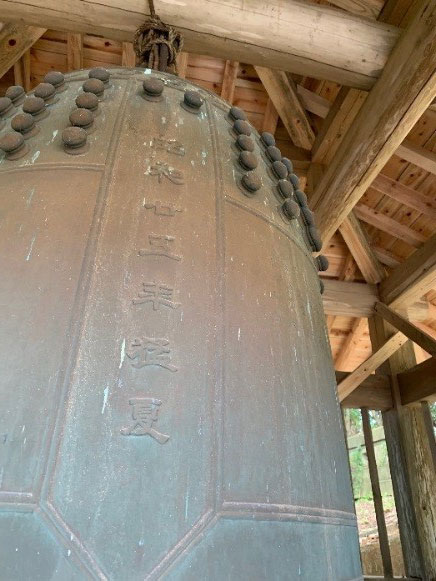9. Temple bell tuned to 122 cycles with Shosoin flute
The courtyard at Chikkou Works displays part of a temple bell. The signboard reads, "Hitachi Zosen Chikkou Works started production of Buddhist temple bells in June 1946. Alloy scraps from dismantled aircraft carriers such as Hosho were used as material to cast 495 bells up to June 1950, including a bell at Shitennoji Temple and Toki-no-Kane(Bell of Time) at the Ohara Museum of Art."
During the Second World War, some 40,000 temple bells were seized throughout Japan. Others were destroyed in the ravages of war. At the time, Chikkou Works employed the services of the monk Endo Yamaguchi, who proposed to managers that the site engage in the reconstruction of temple bells. Because bells are produced in the same way as ship propellers, the managers agreed.(1) However, they set forth the condition that production should respect the history, artistic value, and spiritual significance of Buddhist temple bells, and be based on modern scientific analysis. The monk has noted that this condition set Chikkou Works apart from other companies that undertook bell production, and it was the reason for its success in business.(2) The anecdote speaks both concepts of Japanese spirit, Western technology and the DNA of E.H. Hunter's Challenger Spirit.

"Minami kane do(The South Bell Hall)" at Shitennoji Temple houses a relief print(3) of the inscription on the bell, including its history "February 22, 1950," the names of the "petitioner" and the doctors of engineering and science forming the "founding committee," and Hitachi Zosen Corporation Chikkou Works as the "foundry." The pages discussing the South Bell Hall in Fukko Shitennoji notes the reconstruction was handled by the sound director Mr. I. Aoki, sculpture pattern design supervisor Dr. G. Fujiwara, casting director Mr. H. Nishimura. Tuned to 122 cycles per second using ancient flute of Shosoin Imperial Repository.(4) This bell at Shitennoji Temple, along with those at Kiyomizu-dera Temple in Kyoto, Zenkoji Temple in Nagano, Nyohoji Temple in Koriyama, and Senkoji Temple in Onomichi, was sounded as a New Year's Eve custom and broadcast nationwide over the radio on December 31, 1950.(5)
Toki-no-Kane(Bell of Time) continues to mark the time in Kurashiki City, Okayama. It is decorated with artwork by the woodblock printmaker Shiko Munakata. Elsewhere, on a small hill in Sumoto-machi, Amakusa, overlooking the Yatsushiro Sea, the bell at Enshoji Temple bears the inscription "Summer 1950" on the front and "Mold casting Hitachi Zosen Chikkou Works. Casters Shuzo Nakagawa and Kenichi Moriyama" on the inside. Other bells have been placed in temples throughout Japan.
Temple bells that served as symbols of peace for hundreds of years were melted down to meet the demand for war efforts, and then returned to the temples in the form of bells. "This is an example of the cycle of life, death, and rebirth in Buddhism, called Samsara," says the monk Endo Yamaguchi.(6) One cannot help thinking that the seized Hunter statue was reborn in the form of temple bells, that it is serving as symbols of peace, and that its sweet, serene sound is resonating across Japan. Someone, somewhere, might recognize the resonance as Hunter's challenger spirit.
Bibliography
- 1『日立造船百年史』昭和60年、日立造船株式会社、248p
- 2『日立造船築港工場梵鐘製鋳史』昭和38年、日立造船株式会社
なお、山口円道師による原文は昭和26年2~4p - 3『四天王寺南鐘堂および引導鐘について』 和宗総本山 四天王寺 勧学部 文化財係 渡邉慶一郎様から2018年1月5日にご提供いただいた資料による。
- 4『復興四天王寺』 1981年、総本山四天王寺 (3)の渡邉慶一郎様から2018年1月5日にご提供いただいた資料による。
- 5NHK熊本放送局長宮原孝明様にご提供いただいた資料による。
- 6『日立造船築港工場梵鐘製鋳史』昭和38年、日立造船株式会社 2P
なお、山口円道師による原文は昭和26年2~4p
Click here for various inquiries
- 1. Maizuru Maru
- 2. Hunter and Aiko
- 3. E.H. Hunter & Co. at Kobe Foreign Settlement No. 29
- 4. Rokko Maru: Wooden steamship on the "golden route"
- 5. E. H. Hunter, a man with Japanese spirit and Western technology(part 1)
- 6. Japanese spirit, Western technology (part 2)
- 7. Bronze statue of E.H. Hunter (part 1)
- 8. Bronze statue of E.H. Hunter (part 2)
- 9. Temple bell tuned to 122 cycles with Shosoin flute